There is a potential risk faced when unlicensed electricians are hired as they cause more harm than good. Studies show that they do not have workers compensation insurance thus making the property owners take charge of any possible accidents that may occur in their property or facility.
However, hiring unlicensed electricians’ spells danger and may incur penalties relating to insurance hence house owners should apply caution when dealing with electricians and ensure they are licensed.
Other consequences of hiring an unlicensed electrician include damaging devices beyond repair, fire outbreaks, blown fuses, being fined for hiring an electrician without permission as well as being sued by those harmed by the accident.
Sydney law or policy necessitates an electrician to be licensed or certified. A Sydney -licensed electrician is a person who has met all the necessary requirements of the Department of Fair Trading’s which doesn’t exclude any of the following:
➤ Completion of a 4-year theoretical and practical course in Certificate III in electrotechnology Electrician.
➤ Be issued a proficiency by the Vocational Training Tribunal (VTT) or the Department of Education and Communities (DEC) as an Electrical mechanic or Electrician.
➤ Must have practiced for at least I year however must also be experienced in the use and understanding of the AS/NZS 3000:2007 as required by the current NSW Fair Trading Referee’s Statement Electrical Work form.
The skills and knowledge necessary for work by electricians in Sydney is confirmed by possessions of the qualifications and criterions above.
Sydney law takes into cognizance that humans are imperfect hence licensed electricians are required to have insurance to cover up for accidents that may occur in the course of discharging their duties to clients.
Being a licensed electrician in Sydney means you can install, repair and maintain electrical appliances with zero fuss. It shows you have obtained the minimum requirement needed to work in your community. It entails you can offer rapid and prompt services that are customer friendly giving an outstanding end result.
Difference Between Certified And Licensed Electricians
Certified electricians have credentials issued by an organization be it non-governmental entity or private establishments that attains as a proof of the qualification having met a set standard in the area of specialization in addition to being licensed to practice that is it is a step up or upgrade in the electrical and electronic craft.
The issuing authority of certificates is either private or non- governmental entities or institutions and in some cases by the government. Acquisition of certificates is voluntary and fully dependent on the individual however the issuing body is professional and recognized in society.
A certified electrician has attained speciality in a particular electrical process or machine, like cable slicing or instrumentation and can work without supervision. In addition, he can supervise others as they work.
Before an electrician becomes certified, he or she must have passed an apprenticeship and certification exam. Certification requires an educational backup as no electrician will be certified without passing through the practical (hands-on) and theoretical (written) parts of the course.
The course work is usually completed before, during or after the apprenticeship. However, coursework may be done in a vocational or technical school as well as a community college. In Sydney, the Electrical Equipment Safety System is saddled with the responsibility of certified electricians.
Certified electricians grow as the company grows, it shows commitment to the learning of their craft and this gives clients the feeling of safety as they have hired the best or one of the best in the field.
On the other hand, licensed electricians are those who have permission from a statutory body to perform or work in an approved category. It is the minimum requirement needed to practice.
They have mandatory credentials issued by a government entity identifying the holder as a legally licensed professional in his or her field of specialization. This permission can only be granted or issued by a government entity, institution or establishment.
To practice, it is mandatory that electricians should be licensed. Before one is licensed to practice as an electrician, he or she must have written an exam and scored the minimum passing grade required to be licensed in their various states. Licensed electricians need to periodically renew their licenses on expiration.
How to find out if the electrician is licensed?
Electrical work is possibly the riskiest job to be carried out at home hence house owners should ensure they hire licensed electricians to work for them. However, there are dire consequences for anyone who hires an electrician who isn’t well trained and licensed thus the big question on how to identify a licensed electrician.
It is noteworthy that when choosing an electrician, you need someone who can establish an element of trust and should be able to show his registration details.
The first step to identifying if the electrician is licensed starts with you asking the electrician to check the electrical contractor’s website. On their website, you would see the certification, qualifications, licensure, training and credentials of the electrician.
Other informations provided on the website include electricians’ services, past projects and reviews. Also, ensure you check the status of their licensure by requesting to see evidence of licensure from the electrician.
Qualified electricians would not hesitate but happily provide evidence of licensure and insurance subject to verification by you. To verify the status of the licensure, use the electrician’s full name, his or her electrical company and (or) license number.
Prior to hiring an electrician, you can also verify the state of licensure from the local licensing department of your locality/state or state’s department of labour. This is because requirements for licensure might differ from states.
You might also request the electrician present his or her proof of liability insurance. This proof of liability of insurance will enable you to verify the electricians license with the insurance company.
It is important to note that licensure can be granted to an individual or contractor. In case of the latter, please ensure the contractor verifies the work done by his employees.
In this case where the employee performs the job in place of the contractor, please ensure you confirm the contractor and employees state of licensure as well.
Do well to ensure that the names of the person sent from the contractor matches that on the license. Licensed electricians give warranty for their services, should anything go wrong.
They ensure the integrity of the skilled trades workforce. Above all you can also ask for previous customer reviews to give an insight to their level of professionalism and customer.
Do not be in a haste to hire an electrician and avoid electricians pressurizing you to patronize them. Take your time to compare electricians and their quotes with others before you hire them.
However, to be sure that you are hiring the right electrician, you might ask the following questions before you do business with them.
- How long have you been in the industry?
- Do you offer Free-Onsite quotes?
- Can you tell me how I can save on electricity bills?
- Are you Arctick-Certified?
- Do you offer expert advice?
- Do you offer 24/7 emergency services?
- Are you licensed and insured?
- Do you specialize in residential electrical services?
- Are you a Master Electricians Member?
- Do you offer a warranty for your completed job?
How To Become A Licensed Electrician In Sydney
Are you thinking of being a licensed Sydney electrician? then you are on your way to securing a gold mine. Interesting right?
Moreover, the increasing need for light energy in our present society provides a potential market for those who can install, maintain, test and repair electrical equipment to keep plugged in and switched on too.
Here are the 5 basic steps to become a Sydney based licensed electrician.
- Enroll in a certificate II Electrotechnology. This certificate provides you with the basic knowledge and safety skills needed to build a foundation for work in any electrotechnology discipline. This is a good way to get a sense if being an electrician is a career path you want to pursue further.
- Apply for an electrical apprenticeship. An apprenticeship is usually four years, and will include some structured training through a registered training organization to complete a certificate III in Electrotechnology
- Apply for an Electrician’s License however note that licensing and registration requirements may vary between states, you should check with the licensing body in your state.
- Then practice for at least I year however must also be experienced in the use and understanding of the AS/NZS 3000:2007 as required by the current NSW Fair Trading Referee’s Statement Electrical Work form.
- Have an insurance plan with a reputable insurance company. Being licensed alone doesn’t give you the right to practice. Being insured shows that you are fully ready to practice. When potential clients need to confirm the status of your licensure, he or she checks for your insurance policy too.
When do you need an electrician? You would need an electrician for any of the following:
- Flashing lights – the appearance of this is enough reason to call an electrician as it can lead to a fire outbreak. Flashing light could mean that wires are frayed and need replacement.
- Circuit breaker constantly tripping off due to use of high watt devices used at same time at home.
- During lightning strikes
- Faulty appliances
- Power dips resulting from connecting faulty devices to the electrical grid or use of many electrical devices at same time. Light sags and brightens spontaneously.
- Overload
- Uncovered junction box
- Damaged switches
Why Do You Need A Licensed Electrician?
- Meet the Power Needs of New Appliances – Over the years many people tend to acquire new electronic devices that are added to the ones they already have, thus increasing the electrical consumption in their homes in such a way that their electrical system cannot handle the power demands of such devices.
- Prevent fire risk- An electrical system that is not regularly maintained could have frayed wires and other issues that could create a fire risk. A Sydney-based licensed electrician could help you spot potential fire hazards and, more importantly, fix them.
- Update your Electrical System so that you can rent or sell your estate. If you want to sell or rent a house or office that you bought more than 10 years ago, odds are that it’s currently breaching the building code and this would make it impossible for you to rent or sell this property.
An electrician is a professional tradesperson that specializes in the electrical wiring of buildings, stationary machines, transmission lines and other relevant electrical equipment.
The services offered by these professionals are needed for the installation of new electrical units, servicing, maintenance, replacement, and repair of existing electrical systems. Electricians are categorized under the vocational occupation type.
Electricians are divided into two main categories based on the level of voltage they work with, their speciality skills, and the site of work: Electrical Linemen and Electrical Wiremen.
Electrical linemen set-up power lines, and provide maintenance and repair for these lines.
Industrial and commercial electricians, on the other hand, are classified as wiremen, who typically work with lower voltages used inside buildings. They distribute and connect the client’s electrical equipment through a system of conduits to a power source.
Industrial Electricians
Industrial electricians are highly skilled professionals with wide experience in installing, maintaining, testing, and repairing electrical equipment and systems, particularly in special environments like factories, plants and manufacturing facilities.
They work in a variety of settings and are expected to meet rigorous expectations and very physical job demands while ensuring their safety and the safety of others around them. In order to be fully compliant, and ensure proper execution of their work, industrial electricians must observe all local, state, and of course, national safety codes.
Industrial Electrician Job Description
The principal job requirements of industrial electricians are installation, maintenance, and repair services of different electrical equipment, components, and relevant electrical controls. This requires broad overall knowledge of electrical components, and thorough knowledge of safety codes and regulations as it involves many risks. This role requires a high level of professionalism, technical skills and mechanical proficiency.
Industrial electricians need to be able to understand, interpret and make educated decisions based on technical documents like blueprints, schematics, or verbal instructions.
The job can be quite demanding physically, since typical jobs for installing or repairing equipment require climbing, crawling, or standing for an extended duration of time. Industrial electricians work in uncomfortable and awkward locations where squatting, kneeling or bending may be frequent, and they need to be able to operate tools and machinery in uncomfortable positions for extended periods of time, with no repercussions.
Industrial Electricians’ Work Environment
Industrial electricians are the backbone of technological innovation. They play a big role in installing and setting up hydroelectric, solar, and wind power systems.
Industrial electricians generally work with sophisticated machinery and electrical systems within industrial facilities. In contrast to residential and commercial electricians, these tradesmen ply their trade-in factories and manufacturing plants. They typically work on larger and higher-capacity equipment than their professional counterparts.
Their services are rendered in peculiar environments like:
- Manufacturing plants
- Factories
- Science research centers
- Electrical power companies
- Mining companies
- Construction sites
- Smelters
- Oil and gas refineries
- Shipyards
- Warehouses, etc
Typical Job Responsibilities of Industrial Engineers
In order for production and manufacturing equipment to run smoothly, industrial electricians handle and oversee several day-to-day responsibilities, including:
- Testing existing equipment to determine if components need to be upgraded or replaced.
- Reading, understanding, and interpreting specifications and blueprints.
- Grounding electrical systems.
- Performing scheduled electronic inspections and tests.
- Cleaning circuit boards and contacts.
- Installing, servicing and repairing heavy-duty equipment and industrial communications systems.
- Servicing and repair of existing equipment.
- Management of reports detailing the servicing and rehabilitation of industrial machines.
- Servicing generators, motors, and high voltage systems.
- Maintaining oil levels for motors and replacing wiring on site, etc.
Skills of Industrial Electricians
➤ Proficiency in mechanical aptitude is a key skill, as detailed understanding of mechanics and the capacity to be comfortable around electrical work is non-negotiable.
➤ Another major set of skills an industrial electrician should possess is problem-solving, critical thinking, and acute analytical skills. The ability to analyze electrical problems, analyze and introduce potential solutions is extremely important. They should be able to make use of logic to determine faults in electrical systems.
➤ Motivation is a must as these skilled workers either work on a team along with other tradespeople and professionals or might work alone on projects. They should possess good interpersonal skills and have a keen eye for details.
➤ Strong verbal and written communication skills are also very important, since industrial electricians are expected to read and comprehend different types of texts on a daily basis, including work orders, technical codes, regulations, and equipment manuals.
➤ Time management skills and organizational prowess should be exhibited by these professionals.
➤ Ability to perform physically demanding assignments which may involve lifting heavy objects, climbing ladders, crawling, etc
Education and Training of Industrial Electricians
- High school diploma or GED.
- A college degree is often not essential, but electricians either earn electrical engineering degrees or electrical engineering technology degrees. Examples of such degrees include a Bachelor of Science degree, Diploma of Electrical Engineering, Certificate II in Electrotechnology, etc
- Completion of an electrician program at a trade school or technical institute.
- Journeyman experience/internship. An apprenticeship program is usually about four to five years. It includes structured training through a registered organization.
- Application for an Electrician’s License and passing of the exam.
- Knowledge of electrical systems, hand tools, and industrial equipment.
- Knowledge of necessary maths background.
Salary/Pay of Industrial Electricians
Positions for skilled industrial electricians are on the rise and the pay is robust. There are numerous job opportunities in Australia with an expected 10.9% salary growth within 5 years.
While salaries vary from region to region, the average salary of an Industrial electrician in Australia is about $93,600 per year, with low-entry positions starting at about $80,100 per year and the most experienced worker earning about $112,844 per year.
Commercial Electricians
A commercial electrician is a skilled electrician that has undergone a systematic and rigorous training that focuses on electrical systems in buildings other than residential buildings.
These professionals operate larger systems in big buildings such as shopping malls, office buildings, restaurants, government buildings, etc., essentially any building that is not for residential use.
Commercial Electrician Job Description
The job description of a commercial electrician is quite similar to that of an industrial electrician. The main difference is the work environment: Commercial electricians work in commercial buildings while industrial electricians work in industrial environments.
Commercial electricians handle the installation, design, maintenance and repair of electrical systems and devices in commercial buildings.
This role generally mandates extensive education, skills, and knowledge of electrical systems through study, apprenticeships, and on-the-job training. They typically work on fundamental electrical installations and repairs of basic electrical equipment.
Commercial Electricians’ Work Environment
The work environment of commercial electricians is typically indoors, handling installation and wiring of systems within a wide range of buildings, such as:
- Office buildings
- Medical centers
- Hotels and lodging
- Retails stores
- Multifamily housing buildings
- Farmland
- Malls
- Restaurants
- Garages, etc
The job can be quite hazardous, with a risk of electric shocks and fires, as well as injury from operating tools and equipment while working. The use of safety gear and the rigid compliance to safety codes and regulations can reduce these risks greatly.
Typical Duties of Commercial Electricians
- Installing wiring and electrical components, like switches and light fixtures in buildings
- Analyzing and rectifying problems in wiring and electrical components
- Making use of state, local, and national guidelines for wiring commercial buildings and electrical systems.
- Reading and using technical drawings, blueprints, and schematics
- Repairing faulty equipment and systems
- Interpretation of specifications, schematics, and job orders to labor and staff, as well as allocation of duties
- Servicing, troubleshooting, and installing commercial electrical products
- Testing electrical systems to assess their proper functioning
- Complete documentation of repairs, replacements, and servicing information
- Installing electrical equipment such as transformers, load control devices, regulators, street lights, etc
Skills of Commercial Electricians
➤ Commercial electricians should be able to think technically and critically, as a large part of the role of a commercial electrician involves the diagnosis and troubleshooting of electrical issues. The ability to recognize and solve common problems in electrical systems is an essential skill.
➤ Interpersonal communication skills are very important. Commercial electricians have to properly understand instructions and effectively communicate solutions to clients, often people with little to zero knowledge of electrical systems. These professionals should learn from more experienced colleagues and should equally train apprentices, both of these tasks require good communication skills.
➤ Resourcefulness is an key skill for a commercial electrician. The ability to come up with a creative solution on the spot to quickly solve a sudden problem, especially one that hasn’t been tackled before, is a great advantage for the commercial electrician.
➤ A good commercial electrician should always be professional, presentable, efficient, and reliable in the workplace.
Training and Licensing for Commercial Electricians
- High school diploma or GED.
- A college degree is not essential, but electricians typically earn either electrical engineering degrees or electrical engineering technology degrees.
- Completion of an electrician program at a trade school or technical institute.
- Journeyman experience/internship. An apprenticeship program is usually about four to five years. It includes structured training through a registered organization.
- Application for an Electrician’s License and pass the exam.
- Knowledge of electrical systems, hand tools, and industrial equipment with a minimum number of classroom learning, training, and work experience.
Salary/Pay of Commercial Electricians
The role of a commercial electrician is both lucrative and competitive. The pay varies from location to location, with an average salary ranging between $70,000 to $90,000 per year with the entry-level positions earning close to $50,000, whereas high-earners receive an average of $110,000, inclusive of benefits like overtime, bonuses, tips and commissions.
Similarities Between Commercial and Industrial Electricians
There are a myriad of similarities between commercial electricians and industrial electricians, however, the roles for each job are quite distinct.
Although they both require the same basic education and undergo similar initial training, their professions diverge as their training extends into specialization.
Due to the varying demands of their work environments, electricians need to acquire a unique set of skills to help them navigate their roles and carry out their responsibilities efficiently.
Differences between Industrial and Commercial Electricians
The main difference between the commercial electrician and the industrial electrician is the workplace and environment.
Work environments can also vary for commercial electricians working in different commercial building types, such as retail stores and malls, guaranteeing that the electrical components and wiring are properly and efficiently completed, by using a variety of power tools.
Industrial electricians, on the other hand, typically work in manufacturing and production facilities.
Industrial electricians work with more complicated, sensitive, and expensive machinery in industrial settings, while commercial electricians do not work with such machinery and handle more basic equipment to ensure that the wiring and electrical components of the building are operating optimally.
Industrial electricians target a wider range of electrical systems, from high voltage components to microcurrents, whereas commercial electricians deal with lower voltage electrical systems, generators, special health and safety equipment, large heating and cooling units.
Industrial electricians have more extensive training than commercial electricians because of their work environment in industrial sites. This creates a higher risk and exposure to more hazards and dangers including falls, electrocution, and accidents involving industrial machinery.
Electrical problems at home can be incredibly frustrating. They can lead to loss of power, disrupted technology, the inability to complete specific tasks, and more dangerously to risky and harmful situations.
Electrical problems are actually much more common than many people realize. According to the National Fire Protection Association (NFPA), more than 10,000 fires in residential buildings were caused by faulty wiring in 2017. These fires caused 74 deaths, 1,500 injuries, and more than $1.2 billion in property damage. Fortunately, you can take steps to protect your home from electrical problems.
This article highlights the major electrical problems homeowners experience and how you can prevent them:
1. Overloaded Circuits
A circuit overload occurs when too many appliances are plugged into the same circuit.
For example, if you have a circuit dedicated for an electric oven, plugging in the oven and a stove simultaneously will overload the capacity on the circuit. Plugging too many appliances into the same circuit can cause the circuit to overload and trip the breaker.
Another way a circuit overloads is when the circuit is overloaded with a current rating higher than that of the circuit breaker, causing the breaker to trip.
If you fix a bulb with a high wattage on a light fixture that supports low wattage bulbs, the high temperature of the bulb might melt the socket and the insulation in the fixture, causing sparks to form between wires, and resulting in an electrical fire.
Even if you remove the bulb, the socket and wiring will have already been damaged. Always ensure compliance between the bulb and the fitting wattage to avoid damaging the fixture. If the fixture does not show a marking for the wattage to use, use a bulb with a maximum of 60 watt rating, to be safe.
Make sure not to overload electrical devices, by avoiding plugging too many electrical devices into the same outlet, and monitoring sockets to avoid excess capacity. Excess loads can not only overload electrical circuits, causing circuit breakers to trip but can also damage the electrical equipment.
Circuit overloads are a common cause of electrical fires, so it is essential to maintain the electrical systems in a good condition.
2. Flashing Lights
Generally, high voltage surges, loose connections, or faulty wiring can cause flickering of the light fixtures and dimming of the light output. Additionally, older and outdated electrical equipment can cause failure or dimming and flickering.
Often in older residences, wiring gets damaged over time, causes faults and requires replacement. Also, old light fixtures nearing the end of their lives may cause the lights to flicker or dim and require replacement.
To fix the problem, you can replace the power supply with a “smart” power supply. These power supplies monitor the current and voltage levels in the power supply and regulate them as needed.
You could also install dimmer switches, which deter voltage spikes before they affect the lights, or use motion sensors with CFLs and LEDs.
As a general rule, proper installation of light fixtures and thorough and expert wiring is the key to safekeeping your electrical equipment and avoiding damage and discomfort.
3. Ground Fault Circuit Interrupters (GFCIs)
GFCIs are electrical safety devices designed to prevent electrical shock as they can sense electrical surges and trip the circuit. GFCIs may trip due to faulty operation of appliances, poor wiring or loose connections.
GFCIs can trip even when minor loads are connected, including when you use the electrical system to charge phones or laptops. GFCIs are designed to reset themselves when you turn the power off and back on again. However, some GFCIs may continue to trip even if the problem is fixed.
4. Tripped Circuit Breakers
A circuit breaker is designed to protect your home from electrical overloads. The breaker shuts off automatically when there is too much current drawn from the circuit. Tripping electrical circuit breakers is inconvenient and could have potentially dangerous outcomes. Fortunately, flipping a circuit breaker back on is typically an easy fix.
Several issues can cause circuit breakers to trip.
Most commonly, circuit breakers trip due to a circuit overload, after which you should reset the circuit breaker or turn the power at the breaker box off. Another cause for a breaker to trip is loose wiring, in which case you should tighten the wiring or contact a professional electrician.
Faulty electrical devices, such as lights or dimmer switches, can cause circuit breakers to trip, and you’ll need to reset the circuit breaker but also replace the device as well.
Overloading power boards is also a major and frequent cause for circuit breakers to trip. Most homes and flats, even modern ones, do not have enough power outlets to support, for example, a full home entertainment unit setup.
If your home’s circuit breakers are constantly tripping, it could be due to a circuit overload.
5. Electrical Surges
Electrical surges can cause fires and damage to your electrical appliances and electronics.
An electrical surge occurs when electricity travels faster than usual, usually due to a power outage, damaged ground wires, faulty wiring, improperly installed appliances, or even metal pipe fittings coming into contact with live wires.
Lightning can also cause an electrical surge, and to prevent this problem, you should use a surge protector to detect and block surges before they damage your equipment.
Some surge protectors are very simple devices requiring the user to insert the devices into the outlet and then manually connect the device.
However, other more sophisticated surge protectors have automatic detection, automatic disconnection, the ability to monitor and report voltage/surge conditions to a central monitoring station, and automatic reconnection.
6. Electrical Sockets and Switches Not Working
Electrical sockets and switches are a common source of problems, and there are all kinds of reasons why their operation might fail, from loose wiring to faulty fittings. Over time, the rubber seals around sockets and switches can dry out and become brittle, causing them to break.
The wiring connections to switches and sockets can also become loose over time, so they could stop working altogether. If your socket or switch is loose or is causing an electrical fire, it is essential to fix the problem.
Problems with your electrical sockets and switches can be hazardous, and it is important to address them and fix them as soon as possible, as these problems can put residents at serious risk.
7. Electrical Shock or Electrocution
Electrical shock can occur when the voltage exceeds 120V, for instance when a wall switch is turned off or when lights are turned off. Electric shock occurs when electricity travels through your body and causes severe damage to your body.
Electrical shock is a severe condition as it can cause brain damage, paralysis, severe burns, limb loss, coma, and even death. To help prevent electrical shock, you should unplug any unused electrical devices, and should install ground fault circuit interrupters (GFCI) in any area with potential water risk.
Faulty electrical wiring, faulty outlets, and defective appliances can cause electrical shocks. Ground fault circuit interrupters (GFCI) protect you by sensing when an electrical shock is occurring and shutting off the electricity immediately.
Ground fault circuit interrupters (GFCI) are inexpensive and can be easily installed by an electrician.
8. Poorly Grounded Circuits
Several homes have circuits that lack properly grounded plugs and switches, making them highly vulnerable to electrical shock. If outlets are poorly grounded or even not grounded, the risk of electrical shock increases significantly as a grounded outlet provides an additional safety measure.
A lack of ground connection can cause additional problems, since electrical currents may flow back into the electrical system, leading to circuit overloads and ground faults, which can lead to tripping circuit breakers and may lead to fires.
Furthermore, ungrounded receptacles can overheat, also leading to fires. If your home suffers from such circuits, you should have them inspected and, if necessary, replaced.
9. Power Sags and Dip
Power dips and sags are further types of electrical problems. A voltage dip is a temporary drop in voltage that is often caused by a faulty appliance, whereas voltage sags are long-term drops in voltage that are the result of equipment overloads.
Sags and dips can also be caused by operating several large appliances simultaneously, especially if they are outdated and consume a high amount of power.
Power sags can also affect your home’s heating and air conditioning systems, as HVAC systems must work harder to maintain a comfortable temperature, which can raise your energy bills. The best way to prevent power surges and dips is to unplug appliances that you aren’t using.
When you’re not using your appliances, you can plug them into power strips that can be turned off. That way, you won’t have to worry about unplugging everything when you turn off the power.
10. Loose Wires
One of the most common electrical problems homeowners face is loose wiring. Loose wires can cause fires, which is why it’s important to use electrical tape to fix cables in place. Electrical tape also helps prevent water and insects from getting into wires.
Loose wires are usually the result of wear and tear as wires can get frayed or exposed over time, which can lead to fires. Loose wires can also occur because of damaged or poorly installed wires. Poorly installed connections can lead to arcing, which can loosen ties and create sparks that can cause a fire.
Bottom Line
Your home may suffer from many electrical problems, such as electrical surges which can cause significant and extensive damage to your equipment.
These problems can occur for various reasons, including damaged ground wires, faulty wiring, improperly installed appliances, or even metal pipe fittings coming into contact with live wires.
Sometimes these problems occur due to a loose connection, while at other times the problem could be a faulty appliance or fixture.
Your entire electrical system should be inspected and tested, as it’s not uncommon for the electrical system as a whole to fail, causing wires to short circuit.
When this happens, the entire home’s power may be affected, as the breaker box turns off the power until the wiring is fixed.
Electrical problems can also occur due to faulty appliances, including hairdryers, televisions, air conditioners, and microwaves. These can be quite easy to spot, if appliances are malfunctioning, they require immediate repair.
It’s always advisable to call an electrician to handle the problems. Most electricians are on call 24 hours a day, seven days a week, and they’ll come immediately to assess the problem.
Electrical concepts and work require basic knowledge of the most common electrical terms. This article highlights, defines and explains the most common electrical terms related to electricity.
Also Read: 10 Most Common Electrical Problems In Your Home
Basic Electrical Terms You Should Know
Alternating current (AC):
Simply put, alternating current is an electric current that regularly reverses direction and changes magnitude, in opposition to direct current, which travels in just one direction with respect to time.
More about alternating current
Ammeter

An ammeter is an instrument that detects electric current in amperes. The instrument is calibrated to efficiently measure a wide range of current values, whereby the meter mechanism allows only a tiny fraction of the current directed through the meter at high current values. A shunt fixed in parallel with the meter absorbs most of the current.
Circuit
A circuit is the path an electric current follows, and a simple working electrical circuit is made up of 3 main components: a voltage source, a conductive path and a resistor.
A circuit could also consist of several components, such as a generator or a battery, responsible for generating energy and charging the particles that make up the current; several equipment that use current, such as lamps, electric motors, or computers; and the connecting wires or transmission lines.
Conduit
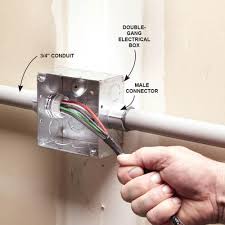
A conduit is essentially a tube through which electrical wires or cables are pulled to pass them through a range of structural or architectural units. The conduit ensures that the wires and cables are shielded from damage and properly distributed.
Wire
A wire is a long, thin, conducting piece of metal used to bind objects or transport electricity. A metallic conductor may not be able to carry electricity without the wire.
Capacitor
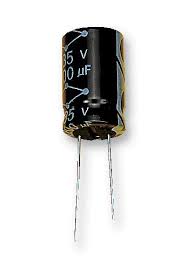
A capacitor is a device that stores electrical charges. Capacitance is the term that describes a body’s ability to hold an electrical charge and the ratio of the object’s electric charge (Q, calculated in coulombs) to the voltage across the object is measured in farads (V, expressed in volts)
Also Read: Licensed Electricians Sydney
Resistor

A resistor is a device that restricts an electric current from flowing through it. It’s also known as a two-terminal passive electrical component having electrical resistance. Primary purposes of resistors in electronic circuits include regulating current flow, modifying signal levels, splitting voltages, biasing active devices, and terminating transmission lines, among other uses.
Conductor
A conductor is another basic electric term. A conductor would be any material, device, or substance that permits electrical current to flow freely. Metal is an example of a conductive substance since it has a low resistance, and the most common conductors available are copper and aluminium wires.
Also Read: Industrial Vs Commercial Electricians-Know The Differences
Insulator
Insulators are substances, devices, or materials that prevent electrical current from flowing freely. The electrons in the insulator’s atoms are closely bonded and cannot easily travel.
Current
The movement of an electric charge via a conductor is known as current (I) and the unit of measurement is Amperes. Electric current is often compared to the flow of water in a pipe.
Circuit Breaker
A circuit breaker is a device that automatically interrupts the electric current in a circuit. After fixing the cause of the overload or failure, the circuit breaker must be restored (closed) to restore electrical current flow. To safeguard circuits against problems, circuit breakers can be used in conjunction with protective relays.
Diode
A diode is a semiconductor device (i.e., it permits the flow of electrical current in one direction only) that has two terminals. When the anode terminal is positive in relation to the cathode, the diodes allows current to flow.
Electrolyte
Electrolyte is a type of material that can conduct an electrical current when it is decomposed into ions in a solution. The operation of a storage battery depends on the liquid medium within, which is an electrolyte solution containing sulphuric acid and water.
Impedance
This is the amount of resistance a circuit creates when a voltage is applied to it. Impedance, unlike resistance, extends the concept of resistance to AC circuits and has both magnitude and phase, whereas resistance just has magnitude.
Inductance
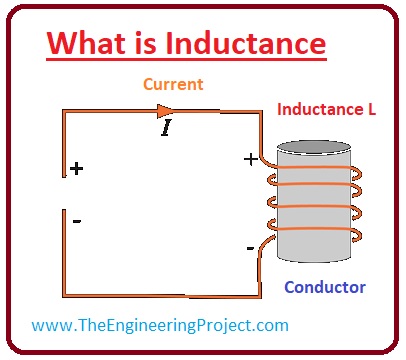
Inductance is an electrochemical characteristic of an electric conductor or circuit that induces an electromotive force to be released when the current flowing changes. It refers to the electrical conductor’s resistance to change in the electric current travelling through it.
Inductor
An inductor is a cable coil twisted around a ferromagnetic material. The inductance of a coil is proportionate to its number of turns.
Ohmmeter
An ohmmeter is a tool that detects the strength of an electrical circuit in ohms.
Power
The pace at which electrical energy is transferred by an electric circuit is referred to as power, which is measured in Watts. Power can be determined as the Force multiplied by distance divided by the time required.
Reactive Power
The amount of electricity that creates and sustains the electric and magnetic fields of AC equipment is called reactive power. Reactive power is created when the current and voltage of an AC circuit are out of phase, and is measured in VARS.
VARS
This is the standard for measuring reactive power. Vars is just the complex conjugate of apparent power or the power flowing into a reactive load, when voltage and current are measured in volts and amperes, accordingly.
Semiconductor
Semiconductor is one of the most used electrical terms. A semiconductor is a crystalline solid, a device, or a substance with a resistivity that fluctuates between that of an insulator and that of typical metals, following the addition of a particle or thermal effects. Semiconductor devices, particularly silicon devices, are critical components of most electronic circuits.
Short Circuit
A short circuit happens when one part of an electric circuit interacts with another component of the same circuit, driving current to find a shorter path and moving electricity away from its original course.
Voltage
Voltage is the pressure induced by the power source in an electrical circuit which permits energized electrons (current) to pass through a conducting loop, allowing them to accomplish their mission. ( V= IR)
Transistor
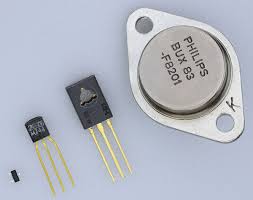
A transistor is a semiconductor device that enhances or switches electronic signals and electrical power. One of the most fundamental components of modern electronics is the transistor.
Series Circuit
A series circuit is a type of circuit layout in which electricity flows through only one path and all of the circuit currents must pass through each load.
Parallel Circuit
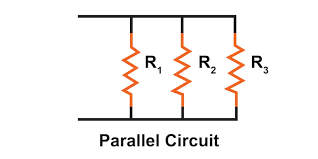
A parallel circuit is another type of circuit layout, where electricity can travel along numerous parallel channels. The entire circuit current is equal to the sum of the individual branch currents, and each load connected to a distinct path receives the whole circuit voltage.
Polarity
Having poles or polars is a trait of polarity. It’s a term that refers to both the positive (+) and negative (-) ends of a magnet or an electrical mechanism like a coil or a battery.
Ohms
An ohm is a unit of resistance measurement. When a circuit transmits a current of one ampere at a potential difference of one volt, the corresponding circuit resistance is one ohm.
Ohm’s law

This is a law that states that the current passing through a metallic conductor is directly proportional to the potential difference across its ends, provided that temperature and other physical features (like pressure) remains constant. (V = IR)
Farad
The farad is the unit of capacitance measurement. One coulomb per volt is equal to one farad.
Henry
It is the measurement unit for inductance. The inductance of a circuit is one Henry if the rate of change of current in a circuit is one ampere per second and the resulting electromotive force is one volt.
Generator
A generator is a tool or instrument that can convert mechanical energy into electrical energy.
Fuse

A fuse is a circuit interrupting device made out of a strip of wire that melts and interrupts an electric circuit when the current crosses past a safe level. After resolving the cause of failure, the fuse must be replaced with an identical fuse of the same size and rating in order to restore the circuit operation.
Frequency
The number of cycles per second is known as frequency. It is the inverse of time (i.e., F= 1/T) and is measured in Hertz (Hz). The frequency of a current is 1 Hz when it completes one cycle per second; 60 cycles per second translate into a frequency of 60 Hz.
Ferro resonance
It is a nonlinear resonance and a type of resonance in electric circuits that occurs when a circuit with a nonlinear inductance is fed from a source with series capacitance and the circuit is disrupted, for example by the opening of a switch.
It can cause the electrical power system to have too much voltage and current, and can pose a risk to transmission and distribution equipment as well as operating personnel.
Electron
An electron is a negatively charged particle that circulates around an atom’s nucleus.
Electromotive Force (EMF)
This is the potential difference that allows an electric current to flow and is measured in Volts.
Dielectric constant
The dielectric constant is a measurement of a substance’s ability to store electrical energy in the presence of an electric field.
Electrolysis
Electrolysis is the chemical decomposition of a substance in a solution or in molten form when exposed to direct current (DC).
Node
A node is a connection point between two or more branches in a circuit, also explained as a junction.
Loop
A loop is any closed path within the electrical circuit.
Mesh
A mesh is any closed path in a circuit which does not host any other closed path inside it.
Branch
A branch of a circuit is an individual leg of the overall circuit with a specific component such as a resistor or a source.
Phasor
A phasor is a quantity that can be used to represent the value of sinusoidal voltages, current, flux and emf.
Transformer
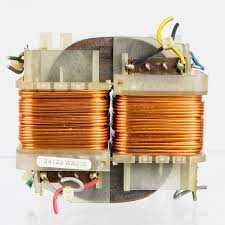
A transformer is a passive component that transfers electrical energy from one electrical circuit to another circuit, or to multiple circuits. Transformers can be either a step-up type (with a higher output voltage than the input circuit) or a step-down type (with the output voltage lower than the input).
Voltmeter
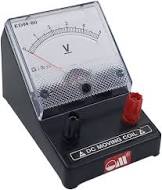
A voltmeter is an instrument used to measure the force in volts of an electrical current. It is also defined as the difference in potential (voltage) between different points in an electrical circuit. Voltmeters that have a high internal resistance are connected across (parallel to) the points where voltage is to be measured.
Conclusion
In conclusion, understanding basic electrical terms is essential for anyone involved in electrical engineering or related fields.
A clear understanding of these terms will enable individuals to effectively communicate and make informed decisions in their work. It’s important to continuously educate oneself on electrical terminology to keep up with the advancements in technology and maintain a strong foundation in the field.



